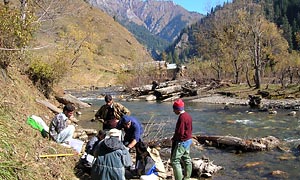Efficacy of conservation strategies for imperiled desert fishes of the Colorado River basin
Date:
August 2018 – May 2021
Abstract:
Understanding the relative strengths of intrinsic and extrinsic factors regulating populations is a longstanding focus of ecology. Recovery programs could benefit from an increased understanding of factors influencing vital rates (growth, recruitment, survival) in small, translocated or reintroduced populations. Translocations, herein defined as the transfer of wild-captured individuals from source populations to new habitats, are widely employed for species conservation, but outcomes are often minimally monitored, and those that are monitored, often fail. In this component of our research in Grand Canyon, we tested hypotheses related to intrinsic (density-dependent) and extrinsic (introduced rainbow trout Oncorhynchus mykiss, streamflow and temperature regime) causes of vital rate variation in endangered humpback chub (Gila cypha) populations translocated to Colorado River tributaries in the Grand Canyon (GC) over 10 years. We used linear mixed-effects models and mark-recapture models to test growth and recruitment or survival hypotheses. While reproduction and recruitment only occurred in one site, multiple lines of evidence supported hypotheses related to density-dependence in survival, recruitment, and growth, and that growth and recruitment were limited by introduced trout. Interestingly, somatic growth increased during intervals with greater flood pulse frequency during monsoon season. We observed lower survival during periods of higher intra-specific abundance and low flood-frequency. Our results suggest tributary translocations can contribute toward the recovery of large-river fishes, but continued suppression of invasive fishes may be required where they persist in translocation sites. Further, we demonstrate the importance of flooding to population demographics in food-depauperate, dynamic, invaded systems.
Funding:
- Bureau of Reclamation
- National Park Service, Grand Canyon National Park
- Center for Colorado River Studies, Department of Watershed Sciences, Utah State University
- Grand Canyon Conservancy
- Arthur L. & Elaine V. Johnson Foundation
- U.S. Geological Survey – Utah Cooperative Fish and Wildlife Research Unit (In-kind)
- The Ecology Center, Utah State University
- Albright-Wirth Grant Program, administered by the National Park Foundation and the NPS Learning and Development Program
Investigators:
- Brian Healy, PhD candidate
- Dr. Phaedra Budy, U.S. Geological Survey – Utah Cooperative Fish and Wildlife Research Unit, Utah State University

PhD candidate Brian Healy and fisheries biologist Emily Omana Smith sampling endangered humpback chub at the mouth of Havasu Creek, a tributary to the Colorado River in Grand Canyon. The successfully translocated population is a focus of this study. Photo: Bryan Smith

PhD candidate Brian Healy releasing endangered humpback chub in Havasu Creek, a tributary to the Colorado River in Grand Canyon. The successfully translocated population is a focus of this study. Photo: Amy Martin/NPS


